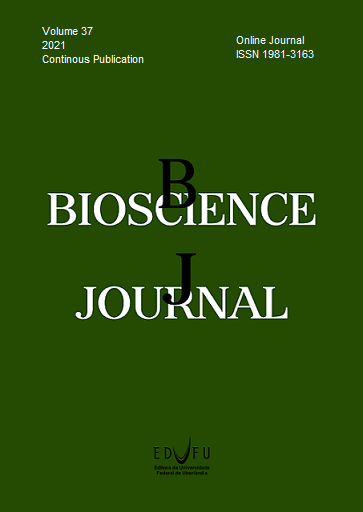Characterization and plasticity of wharton's jelly mesenchymal stem cells of goat
DOI:
https://doi.org/10.14393/BJ-v37n0a2021-50386Keywords:
Cell Culture, Flow Cytometry, Lineage Differentiation, Mesenchymal Stem Cells, Umbilical Cord Matrix.Abstract
Mesenchymal stem cells (MSCs), obtained from several anatomical sites, have already been described, characterized and used in therapeutic models for tissue repair. The umbilical cord mesenchymal stem cells, represented by cells from arteries and veins walls, as well as Wharton's jelly are easy to be obtained, highly available, require no invasive procedure, do not present risk to donors and do not present ethical limitation. The aim of this research was to analyze the plasticity of Wharton's jelly mesenchymal stem cells (WJ-MSCs) of goat, evaluating their behavior in vitro and characterizing them immunophenotypically. Thus, tests were performed on colony forming units, viability and cell growth curve, flow cytometry analysis and plasticity potential. Goat umbilical cord matrix cells exhibited fibroblastoid morphology with colony formation and self-renewal ability, always maintaining their undifferentiated state up to the eighth passage (P8). The growth curve kinetics exhibited the LAG, LOG, and DECAY phases, without displaying a PLATEAU phase. The plasticity assay demonstrated positive differentiation for osteogenic, adipogenic and chondrogenic lines, characterized by the synthesis of intracytoplasmic granules or extracellular matrix with the presence of calcium, lipids and proteoglycans. Flow cytometry demonstrated the expression of CD90 and CD105; absence of CD14 expression. It is concluded that the cell population isolated from the Wharton's jelly of goat constitutes a representative sample of mesenchymal stem cells, with great possibilities in the field of regenerative and reproductive medicine.
References
ARGÔLO NETO, N.M., et al. Isolation, expansion, differentiation and growth kinetics essay in mesenchymal stem cells culture from the bone marrow of collared peccaries (Tayassu tajacu). Acta Scientiae Veterinariae. 2016, 44(1), 1-11. https://doi.org/10.22456/1679-9216.80850
BASTAWROUS, M., et al., 2016. Wharton’s jelly stem cells. In: FAUZA, D.O. and BANI, M., eds. Fetal Stem Cells in Regenerative Medicine. New York: Springer, pp. 257-276. https://doi.org/10.1007/978-1-4939-3483-6
COSTA, C.R.M., et al. Labeling of adipose-derived stem cells with quantum dots provides stable and long-term fluorescent signal for ex vivo cell tracking. In Vitro Cellular & Developmental Biology-Animal. 2017, 53(4), 363-370. https://doi.org/10.1007/s11626-016-0121-2
DA ROCHA, A.R., et al. Hematopoietic progenitor constituents and adherent cell progenitor morphology isolated from black‐rumped agouti (Dasyprocta prymnolopha, Wagler 1831) bone marrow. Microscopy Research and Technique. 2012, 75(10), 1376-1382. https://doi.org/10.1002/jemt.22077
DE SCHAUWER, C., et al. Markers of stemness in equine mesenchymal stem cells: a plea for uniformity. Theriogenology. 2011, 75(8), 1431-1443. https://doi.org/10.1016/j.theriogenology.2010.11.008
DESANCÉ, M., et al. Chondrogenic differentiation of defined equine mesenchymal stem cells derived from umbilical cord blood for use in cartilage repair therapy. International Journal of Molecular Sciences. 2018, 19(2), 537. https://doi.org/10.3390/ijms19020537
DONDERS, R., et al. Human Wharton's Jelly-derived stem cells display a distinct immunomodulatory and proregenerative transcriptional signature compared to bone marrow-derived stem cells. Stem Cells and Development. 2018, 27(2), 65-84. https://doi.org/10.1089/scd.2017.0029
DONOFRIO, G., et al. Susceptibility of bovine mesenchymal stem cells to bovine herpesvirus 4. Journal of Virological Methods. 2005, 127(2), 168-170, 2005. https://doi.org/10.1016/j.jviromet.2005.02.019
EL-ASHMAWY, N.E., et al. Effect of human umbilical cord blood-derived mononuclear cells on diabetic nephropathy in rats. Biomedicine & Pharmacotherapy. 2018, 97, 1040-1045. https://doi.org/10.1016/j.biopha.2017.10.151
GAUTHAMAN, K., et al. Human umbilical cord Wharton's jelly stem cell (hWJSC) extracts inhibit cancer cell growth in vitro. Journal of Cellular Biochemistry. 2012, 113(6), 2027-2039. https://doi.org/10.1002/jcb.24073
GUGJOO, M.B., et al. Goat mesenchymal stem cell basic research and potential applications. Small Ruminant Research. 2020, 183, 106045. https://doi.org/10.1016/j.smallrumres.2019.106045
MOHAMMADI, M., et al. Effect of gestational age on migration ability of the human umbilical cord vein mesenchymal stem cells. Advances in Medical Sciences. 2018, 63(1), 119-126. https://doi.org/10.1016/j.advms.2017.08.002
MOSHREFI, M., et al. Isolation and characterization of mesenchymal cells isolated from caprine umbilical cord matrix. Animal Reproduction. 2018, 7(4), 367-372.
PRIETO, P., et al. Cell expansion-dependent inflammatory and metabolic profile of human bone marrow mesenchymal stem cells. Frontiers in Physiology. 2016, 7, 548. https://doi.org/10.3389/fphys.2016.00548
PURANIK, S.B., et al. Isolation of mesenchymal-like cells from Wharton’s jelly of umbilical cord. International Journal of Pharmaceutical, Chemical and Biological Sciences. 2012, 2(3), 218-224.
ROCHA, A.R., et al. Immunophenotyping, plasticity tests and nanotagging of stem cells derived from adipose tissue of wild rodent agouti (Dasyprocta prymnolopha). Arquivo Brasileiro de Medicina Veterinária e Zootecnia. 2019, 71(5), 1571-1581. https://doi.org/10.1590/1678-4162-10677
ROCHA, M.A.C., et al. Allogeneic mesenchymal stem cells and xenogenic platelet rich plasma, associated or not, in the repair of bone failures in rabbits with secondary osteoporosis. Acta Cirurgica Brasileira. 2017, 32(9), 767-780. http://dx.doi.org/10.1590/s0102-865020170090000009
SARGIACOMO, C., et al. Upregulation of sodium taurocholate cotransporter polypeptide during hepatogenic differentiation of umbilical cord matrix mesenchymal stem cells facilitates hepatitis B entry. Stem Cell Research & Therapy. 2017, 8(1), 204. https://doi.org/10.1186/s13287-017-0656-5
SIRONI, F., et al. Multiple intracerebroventricular injections of human umbilical cord mesenchymal stem cells delay motor neurons loss but not disease progression of SOD1G93A mice. Stem Cell Research. 2017, 25, 166-178. https://doi.org/10.1016/j.scr.2017.11.005
SOARES, I.M.V. et al. The influence of Aloe vera with mesenchymal stem cells from dental pulp on bone regeneration: characterization and treatment of non-critical defects of the tibia in rats. Journal of Applied Oral Science. 2019, 27, e20180103. https://doi.org/10.1590/1678-7757-2018-0103
TAGHIZADEH, R.R.; CETRULO, K.J. and CETRULO, C.L. Wharton’s Jelly stem cells: future clinical applications. Placenta. 2011, 32, S311-S315. https://doi.org/10.1016/j.placenta.2011.06.010
VOLAREVIC, V., et al. Stem cells as new agents for the treatment of infertility: current and future perspectives and challenges. BioMed Research International. 2014, 2014, 507234. https://doi.org/10.1155/2014/507234
XIE, J., et al. Umbilical cord-derived mesenchymal stem cells alleviated inflammation and inhibited apoptosis in interstitial cystitis via AKT/mTOR signaling pathway. Biochemical and Biophysical Research Communications. 2018, 495(1), 546-552. https://doi.org/10.1016/j.bbrc.2017.11.072
Downloads
Published
Issue
Section
License
Copyright (c) 2021 Gustavo Cardoso da Silva Neves, Napoleão Martins Argôlo Neto, Maíra Soares Ferraz, Clautina Ribeiro de Moraes da Costa, Andressa Rêgo da Rocha, Huanna Waleska Soares Rodrigues, Felipe de Carvalho Nunes, Camila Ernanda Sousa de Carvalho, Miguel Ferreira Cavalcante Filho, Danilo José Ayres de Menezes, Maria Acelina Martins de Carvalho

This work is licensed under a Creative Commons Attribution 4.0 International License.





